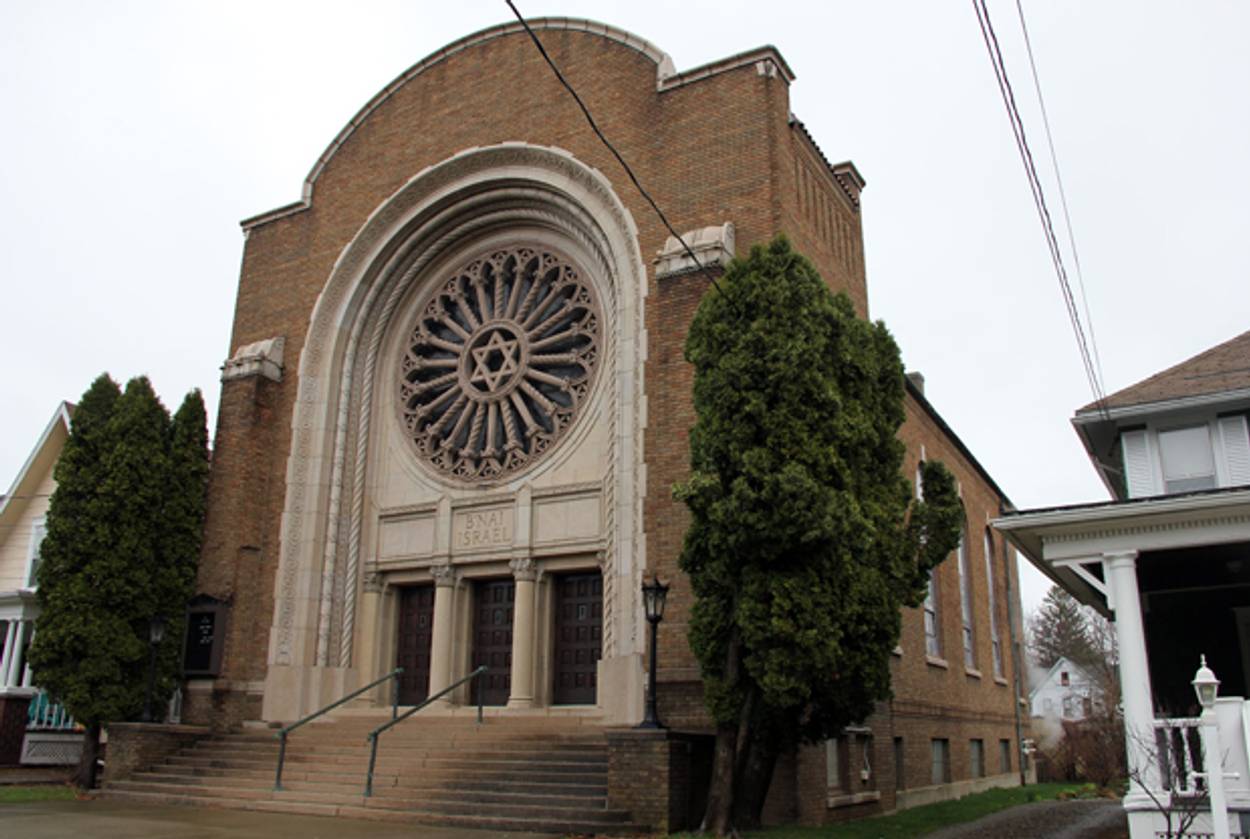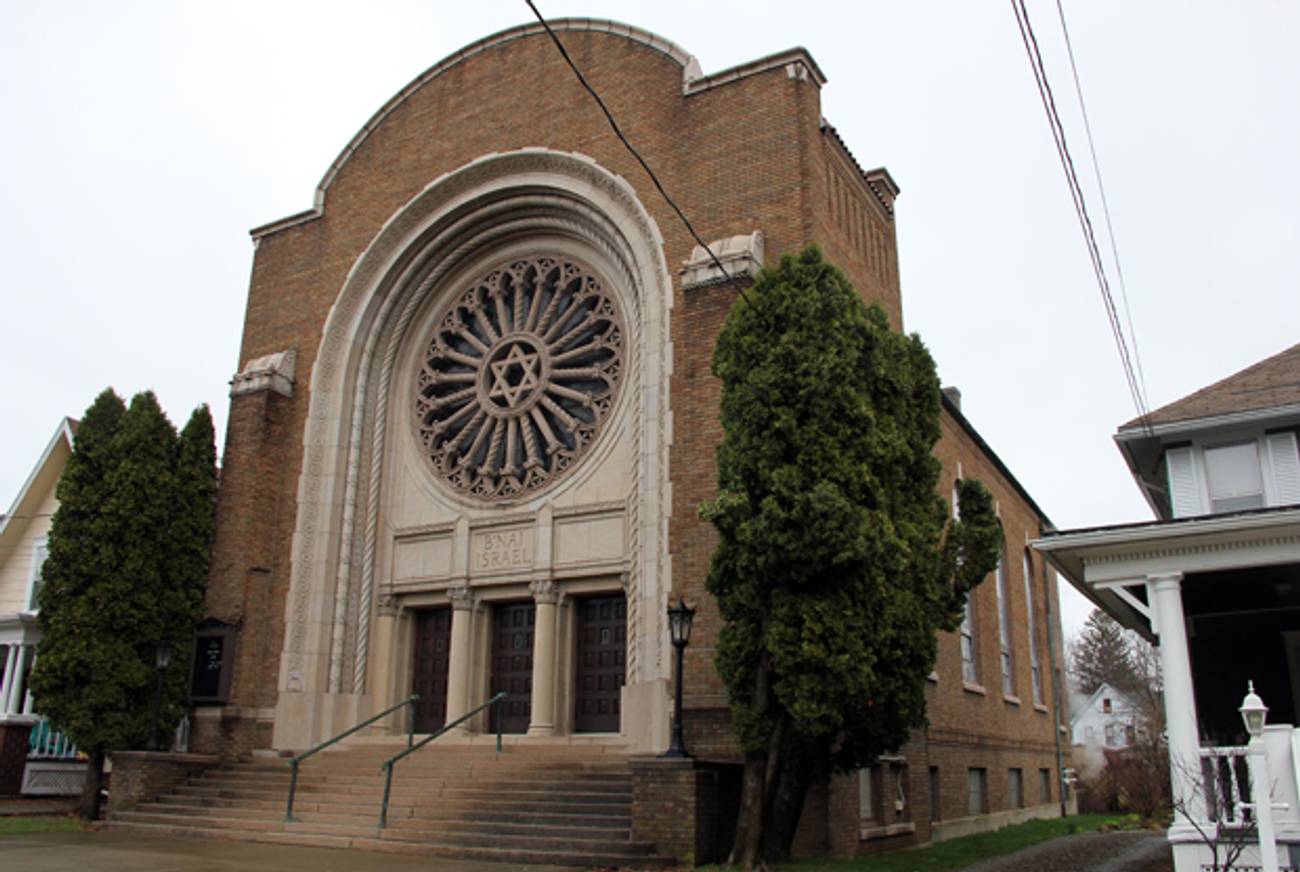Registered
A small temple in Olean was just added to the National Register of Historic Places, but for one girl growing up there, it always had cultural significance




On Sept. 29, 1929, a group of 20 or 30 Jewish men, draped in talleisim and chanting prayers, marched down North Union Street, the main thoroughfare in Olean, a small city in rural Western New York. Their sacred mission: carry the Torah from its former home in rented space in an office building to its new location—the imposing new Temple B’nai Israel several blocks away. When they arrived at the building— its most dramatic feature was a massive arch that framed a leaded-glass window with a Star of David and three large wooden doors—marchers were met by local dignitaries and rabbis and cantors from Syracuse and Bradford, Pa. The Jews of Olean, this elaborate public demonstration announced, were here to stay.
This month, Temple B’nai Israel was added to the National Register of Historic Places as a cultural and architecturally significant site and cited as a “highly intact example of an early twentieth-century synagogue in a small city.” Jewish communities in small cities rarely get the attention they deserve, overshadowed by their more prevalent and visible urban compatriots, so this honor is particularly welcome.
My grandfather, Abraham Solomon, was not one of the men who carried the Torah that day in 1929. He and my grandmother arrived in Olean a few years later. They emigrated from Russia to New York City in the early years of the century and later trekked west to find a better place to make a living. Many Jewish communities were populated by similar pioneers who added transcontinental journeys to their earlier transoceanic voyages. My grandparents—who by then had grown children—got as far as Joliet, Ill. Disappointed with the Midwest, they headed back east, found a vacant store in Olean, and opened a non-kosher meat market. There clearly weren’t enough Jews there to support a kosher establishment, but my grandparents must have been reassured by the presence of that big synagogue.
My father, then a struggling young lawyer in Albany, brought his wife and me, then 4 months old, to Olean in 1935 to help his father in the store. It was supposed to be a temporary arrangement, but in Olean my tall, good-looking father grew into his nickname—King Solomon—and none of them ever left. And so I spent my early childhood in Temple B’nai Israel.
When I was ready for school, my parents, grandparents, and I moved out of Olean to Portville, a tiny village several miles closer to Pennsylvania. Actually we didn’t live in Portville; we lived on the road to Portville. My family ran the Highway Market next to our house. In back were a slaughterhouse and barn—both frequently used. There were no boundaries between our struggling business and our squabbling multi-generational family.
School should have been a haven. But as soon as I began kindergarten in Portville, I realized that I was different from all the other children—the only Jew ever to attend the school. One day I realized that my classmates’ parents had told them to stay away from me; as some of the more candid children explained, Jews killed Christ and were forever damned. I told my parents about my isolation, but they never complained to teachers or the principal. It seems clear now that they likely feared making trouble would hurt business—and perhaps they were right. So, I sat quietly in the back of the room on Wednesdays as my classmates lined up for released time for religious education—Presbyterians, Methodists, Lutherans, a few Catholics. The room grew larger and I grew smaller in it as I waited for the end of the school day.
As the years passed, outright slurs decreased and my classmates and I reached an unspoken agreement. We shared classes and enjoyed school activities but not social events or holidays—which was just fine with my mother, who discouraged fraternization. And I soon realized, as our congregation welcomed several refugee families from World War II, that the anti-Semitism I experienced was trivial compared to what was happening to Jews in Europe. I absorbed their stories of persecution and losses just as earlier I had listened to my grandmother’s tales of pogroms.
Although I did not fully belong in Portville, at Temple I was a favored child, Queen Esther every day of the year. In Portville I stood out not just for being Jewish but for being smart. In Temple I was expected to be smart. The Temple was a place of worship, nominally Conservative but including Orthodox and Reform factions. More important to me, it was a community center. The small number of other Jewish kids went to school in Olean, so I saw them only at Temple services and holiday celebrations.
At one event I recall declaiming Emma Lazarus’ poem “The New Colossus.” I raised my arm dramatically as I recited, “I lift my lamp beside the golden door” to the cheers and sobs of the old men and women who had been there and seen that. Later, when I was in college, I went to a New Year’s Eve Temple dance on a blind date with a young man visiting from New York. Eighteen months later, we were married in the Temple sanctuary. I left Olean to learn to become a New Yorker.
When my father died, the road leading to the Highway Market (now Portville village offices) was renamed King Solomon Way. And there are other traces of the past: A street in Olean was renamed Leo Moss Drive, to honor a respected refugee physician. The late Sonja van der Horst, a Holocaust survivor, donated her Olean home to the Temple and used the reparations she received from Germany to establish a professorship in Jewish history and culture at the University of North Carolina. And, of course, now Temple B’nai Israel has been recognized as a culturally significant site. For me, it always was.
Correction, Jan. 20: This article originally stated that Sonja van der Horst established a professorship at Duke. It is at the University of North Carolina.
Update December 9, 2020: The synagogue is being deconsecrated and will now serve as a community theater.
Carol Levine directs the Families and Health Care Project at the United Hospital Fund.